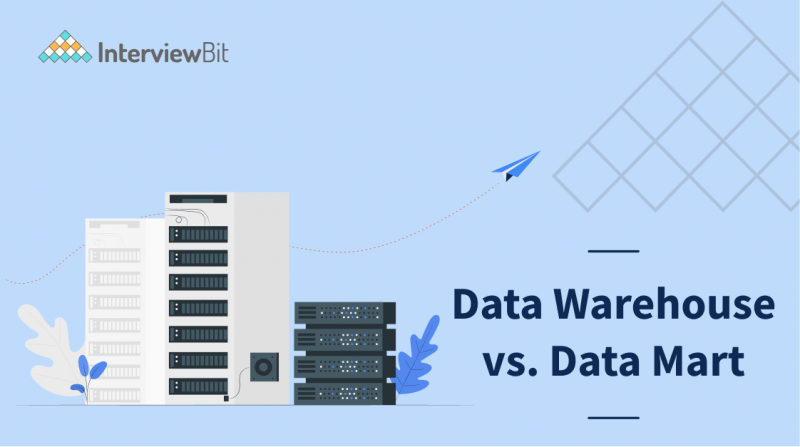Introduction
Everyone has heard the term Data and of course, knows its importance in today’s world. Let’s discuss it more. Basically, there is raw data at first which can be described as data in its most basic form. On this raw data, processing takes place and this data gets converted to information. Now, this processed data is analyzed and used at different levels to draw conclusions and make decisions. For a company or business, data is everything. It can get started but can’t sustain itself in the market without it. The data of a company helps it to analyze the company’s or employee’s performance, stand out in the competition, and make decisions.
As we have seen how important data is, now let us jump on how data is stored to process and analyze at a company level.
Companies use Data Warehouse and Data Mart for storing their data. A data warehouse is a database that contains data from all departments of a company and a data mart is a database that stores data of a particular department. There can be multiple numbers of data marts according to departments. Both of these are very much similar but are used for different purposes. The main difference is – Data Warehouse is data-oriented in nature. While Data Mart is project-oriented in nature. The other difference between these two is – Data warehouse is large in scope whereas the Data mart is limited in scope.
Confused about your next job?
What is a Data Warehouse?
It is a collection of data that is separate from the operational systems and supports the decision-making of the company. For example, a company has different departments like Sales, Finance, HR, and Marketing. By integrating and modeling this data, data analytics experts can help to empower employees in all departments, improve customer experience, improve sales, manage finance, and whatnot. In a data warehouse, a company stores data from a perspective so that they have all the data from the past as well to perform analytics over it. It’s a key component of a data analytics architecture, which helps to create an environment for decision support, analytics, business intelligence, and data mining.
For example, suppose there are different data sources having data related to Transactions, CRM details, and Flat files, as we can see from the above figure as well. Now, this data gets stored in the staging area where the ETL process takes place. ETL implies – Extract, Transform, Load.
- Extract: Data from different data sources is extracted and then stored in the staging area.
- Transform: In the staging area, data transformation takes place according to business needs like filtering, sorting, removing duplicates, etc.
- Load: The transformed data is then loaded to the warehouse.
Now the data warehouse can be assumed as an integrated database having data from various sources. From this data warehouse, subtypes are created which are called data marts. These have data related to different departments like marketing and sales. If a separate analysis has to be performed department-wise, then it can be analyzed easily. We will discuss data marts in more detail in the next section.
A data warehouse can be classified as:
- Enterprise Data Warehouse (EDW): Enterprise Data Warehouse (EDW) is a centralized warehouse. It provides decision support for the enterprise. It offers an approach for organizing and representing data. It also provides the ability to classify data according to a particular subject or department in the enterprise.
- Operational Data Store: ODS are data stores required when neither Data warehouse nor OLTP systems support organizations reporting needs. In ODS, the data present in the Data warehouse keeps on updating in real-time. Hence, it is widely preferred for routine activities like storing records of the Employees, as new Employees keep on adding.
- Data Mart: A data mart is a collection of data, that is a subset of the data warehouse. It is completely subject-oriented. Like data of different departments can be stored in data marts.
What is Data Mart?
A Data mart is a simple form of a Data Warehouse. It is focused on a single subject or we can say, focused on a particular part of a company (say a department ). It contains data from a few sources with information specific to a department. If an HR manager wants to see the details of employees who have created a large impact on a company by crossing their sales target, then easily it can be seen through data marts. He can extract the data through a data mart and analyze it quickly because of the limited size of the data.
A Data mart collects data from only a few sources. These sources may be central Data warehouses, internal operational systems, or external data sources. And based on these sources we can define the type of data mart. Let us discuss the classification of Data marts based on sources.
There are different types of data mart – dependent, independent, and hybrid.
Dependent Data Marts
These are the subdivisions of a larger data warehouse. These are created according to the top-down approach — you first create a data warehouse and then design data marts on top of it. Dependent data marts are compatible with larger companies that require better control over the system’s performance.
As we can see in the below figure, Data warehouse collects data through ETL process from various data sources. Then the Dependent data mart collects data from the data warehouse. And from this Data Mart, the data can be queried upon for further analysis.
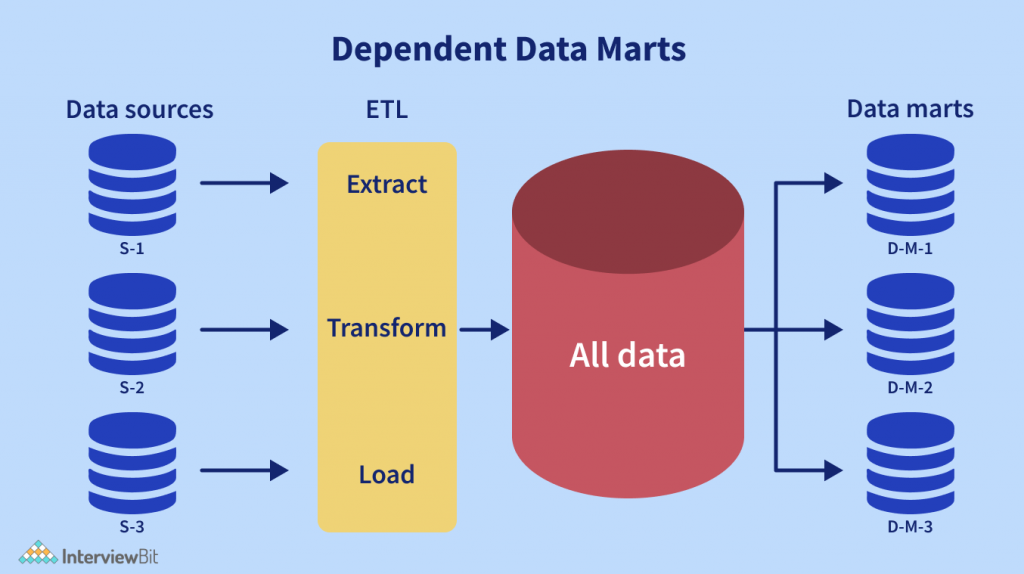
Independent Data Marts
These act as standalone systems, i.e, they can work without a data warehouse. As we can see in the figure below as well, Independent data mart collect data directly from data sources rather than a data warehouse. The data present in it can be used further to create a data warehouse. This approach is called the bottom-up approach. These work great for small to medium-sized companies.
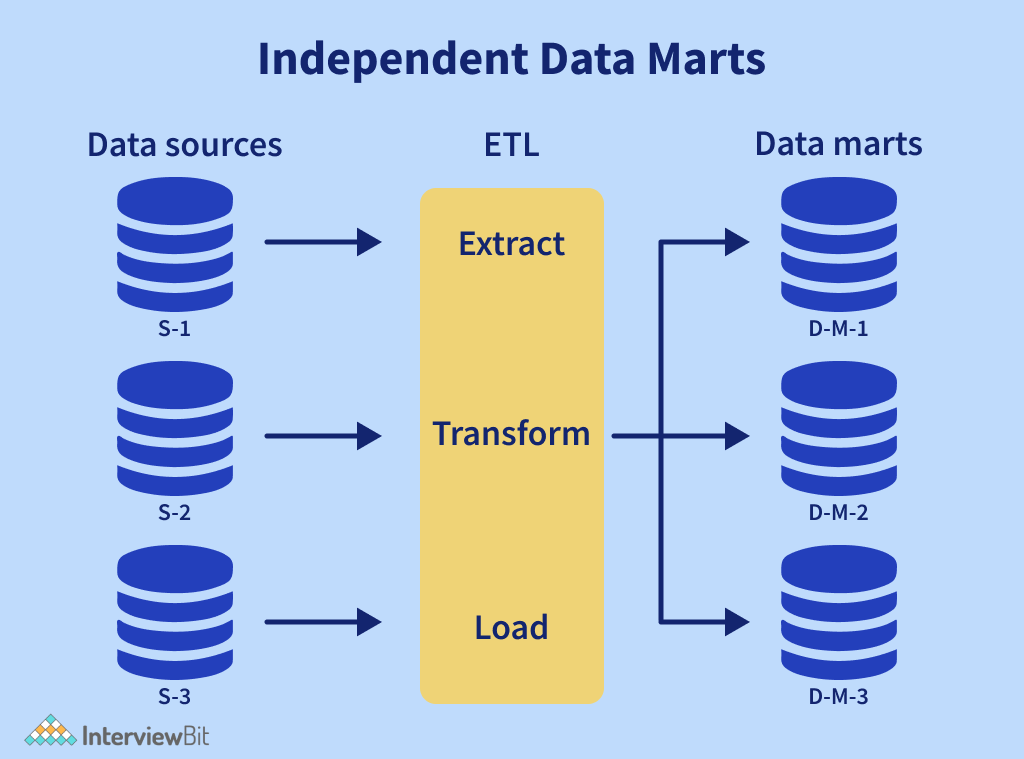
Hybrid Data Marts
As the name suggests these data marts can collect data either from the data warehouses or directly from the data sources.
In the below figure, we can see that the data marts have the capability to collect data either from the data warehouse or directly from data sources through ETL Process.
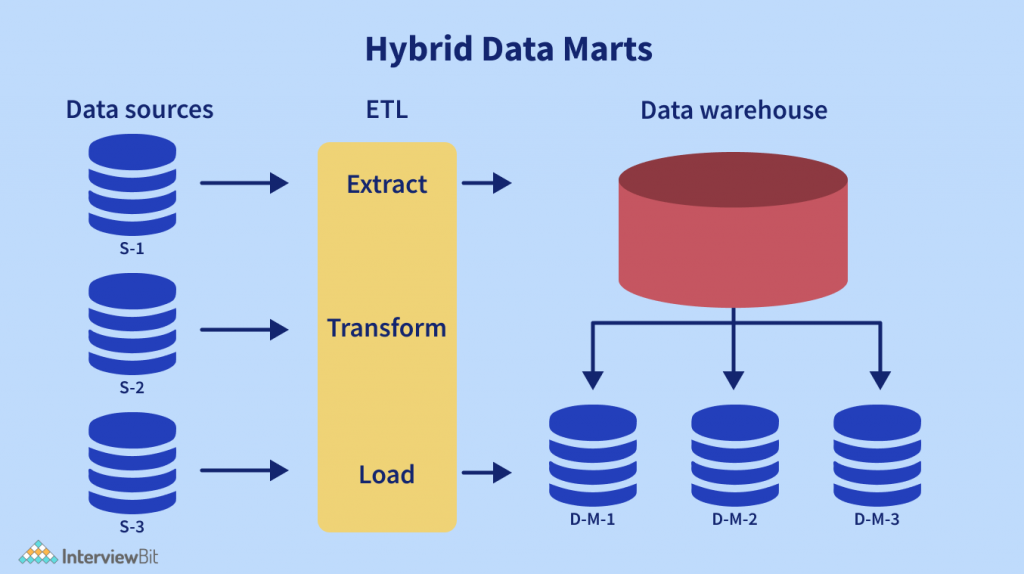
Key Differences: Data Mart vs Data Warehouse
- Data Warehouse stores a large amount of data which is collected from different sources whereas Data Mart contains only the specific data from data warehouse, which is required by the company for analysis.
- Data Warehouse contains the data of all departments in an organization whereas Data Mart has data of specific departments only
- Data warehouse contains a lot of data and due to the huge amount of data, performing data operations on it is very time consuming. On the other hand, Data marts contain less amount of data and hence data operations in Data Mart take less time.
- Data Warehouse designing process is complicated because of different forms of complex data whereas the Data Mart designing process is easy.
- Data Warehouse usually has storage of about 100 GB to 1 TB+ whereas Data Mart has less than 100 GB.
- A Data Warehouse implementation process usually takes a month to a year, whereas a Data Mart implementation process usually takes a few months to complete. What is the Implementation process? In the implementation process firstly, a data warehouse or data mart is designed and constructed, and after that data is populated, accessed and managed, according to requirement.
Data Warehouse Vs Data Mart: Difference and Comparison
Despite being types of a database, data warehouse and data mart have differences based on different parameters. In the following section let us compare, data mart vs data warehouse.
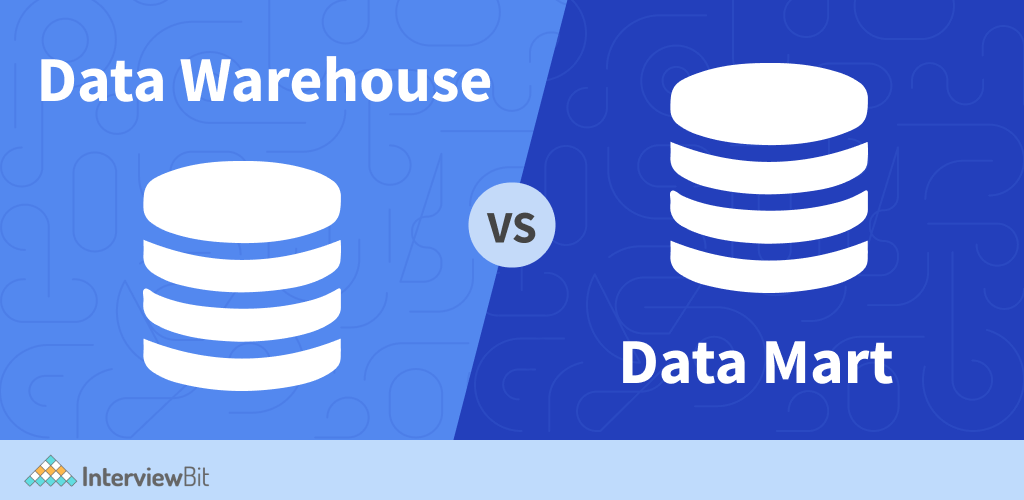
| Parameter | Data Warehouse | Data Mart |
| Definition | A Data warehouse collects data from various data sources. | A Data mart generally stores data from a particular unit within an organization. For example, the finance department or the sales department, etc. |
| Objective | To become a single source of all data needed. | To become a source of a particular subject only, like of a particular department. |
| Scope | The scope is wide as it contains data from all departments. | The scope is specific as individual data marts are present for individual departments. |
| Nature | It is data-oriented in nature i.e, The main purpose of a data warehouse is to store all of the data related to the company. | It is project-oriented in nature i.e, A data mart stores data specific to a particular department only. |
| Data type | Data is contained in a detailed form in a data warehouse. | Data is contained in a summarized form in a data mart. |
| Data Handling | Because of large data, it takes a long time to process data. | Takes less time to process data, as it only handles a small amount of data. |
| Subject-area | Provide a coherent picture of all the departments in the business at a point in time. | Mostly hold only one subject area- for example, Sales department or Finance department. |
| Design | The Design Process of creating schemas and views in a Data warehouse is complicated. | The Design process of creating schemas and views in a Data mart is easy. |
| Cost | For on-premises $100K+ and on-demand pricing varies (SaaS). | For on-premises, $10K and on-demand pricing varies (SaaS). |
| Maintenance | The maintenance is a little difficult because of the large storage and complex data. | Maintenance is easy as compared to data warehouses. |
| Implementation time | The implementation process of Data Warehouse can take a few months or even a few years. | The implementation process of Data Mart takes only a few months. |
| Usage | It helps to make a strategic decision for Company. Like what should be the strategy for the next five years, for the company’s success. | It helps to make tactical decisions for the business. Like if a product’s sale is decreasing for some time then what should be done next? |
| Data storing | Designed to store enterprise-wide decision data. | Dimensional modeling and star schema design are employed for optimizing the performance of the access layer. |
| Duration | In the Data warehouse data exists in it for a longer duration. | In the Data mart, data exists only for a shorter period of time. As it can collect whatever the data it needs from centralized storage i.e., a data warehouse at any time. |
| Model | It is a top-down model. | It is a bottom-up model. |
Conclusion
Data plays a major role everywhere. For the companies to stand out they need proper data storage methods and then need analysis based on different parameters on them, to make decisions on department level or on an organizational level. A data warehouse is the type of database that stores data coming from different sources, of all the departments. Whereas Data marts are the type of database that stores data at the departmental level. All of the department-related decisions are made based on data mart and all of the organizational level decisions are based on Data warehouse.
Frequently Asked Questions
Q. What is the core difference between a Data warehouse and a Data mart?
A. Data Warehouse stores huge amounts of data while data mart stores less amount of data. Data warehouse is data-oriented in nature as it stores all the data of a company. While Data Mart is project-oriented in nature as it stores data related to a particular unit of a company e.g, department or project.
Q. What is an Independent Data Mart and which type of organization can use an Independent Data mart?
A. Independent Data Marts are standalone systems, i.e, they can work without a data warehouse. They collect data directly from data sources rather than a data warehouse. The data present in it can be used further to create a data warehouse. This approach is called the bottom-up approach. These work great for small to medium-sized companies.
Q. What is the purpose of the staging area?
A. A data warehouse collects data from various data sources. But before it collects the data, it is stored in Staging area. The purpose of this staging area is to transform the data as per business requirements. After transformation data is sent to the data warehouse.
Q. What is the difference between the bottom-up and top-down approaches?
A. In the bottom-up approach, data marts are created first and then from them data warehouses are created. This type of strategy works best for small to medium-sized companies.
In the top-down approach, first data is fetched in a data warehouse, and then from them data marts are created. This type of approach is generally followed and best for big companies since they have more data as compared to small to medium-sized companies.
The approach selection is based on the company size.
Q. What are the basic steps in implementing a data mart?
- Designing
- Constructing
- Populating
- Accessing
- Managing







 Join WhatsApp Group
Join WhatsApp Group
